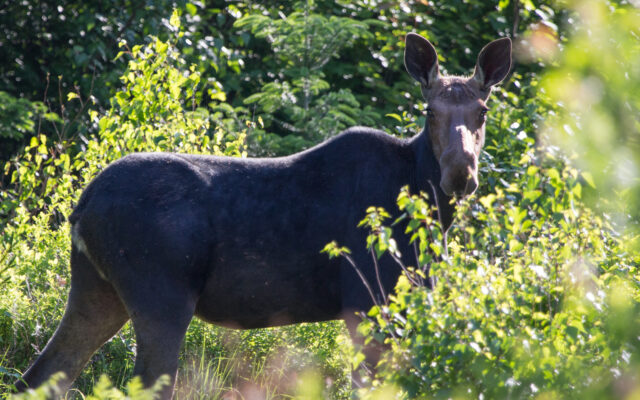
Special cow moose hunt aims to thin herd to reduce impact of winter ticks
By Pete Warner, Bangor Daily News Staff
Winter ticks are the most significant threat to the health of Maine’s moose population.
This week, hunters are taking part in an experiment designed to find out whether the impact of the parasites can be lessened and the herd’s health improved.
The Maine Department of Inland Fisheries and Wildlife on Monday began a special moose hunting season called the Adaptive Unit Hunt in the North Maine Woods north of the Golden Road. Biologists studying the effects of winter ticks on the state’s moose herd are overseeing a cow-only hunt in a subsection of Wildlife Management District 4 that it hopes will significantly reduce the number of female moose in that area.
The aim is to determine whether decreasing the density of the herd in an area of high moose concentration such as the study area (WMD 4A) can break or lessen the impact of winter ticks on the herd.
“As wildlife managers, the only solution that we have to the issue that we’re seeing with winter tick is to try, in a very limited area, to experimentally reduce moose numbers using hunters to determine if that lessens the impact of winter tick on calf survival, and other reproductive measures and health measures,” said Nate Webb, the DIF&W wildlife division director.
The Adaptive Unit Hunt is part of a multiphase study that began in 2019 and is expected to run through at least 2025. It focuses on the western half of WMD 4 and covers 2,000 square miles. Hunters are assigned to either the northern or southern half of the subunit.
The work began with helicopter surveys that assessed the moose population in the area. Sixty moose calves, 30 in each section of WMD 4, were captured and fitted with GPS collars to monitor their survival.
The 2021 hunt, for which 550 cow permits were distributed, is the second phase of the study. The Adaptive Unit Hunt is divided into three separate weeks: Oct 18-23 (200 permits), Oct. 25-30 (150) and Nov. 1-6 (200).
Zone 4A makes up approximately 6 percent of the state’s core moose range, according to DIF&W.
The entirety of WMD 4, including sub-unit 4A, has already been open to hunting during the first two weeks of the regular moose season (Sept. 27 to Oct. 2 and Oct. 8 to 13).
There were 500 permits allotted for those weeks in WMD 4 (including 4A), but 400 of those were for bulls only. According to the DIF&W Big Game Harvest Dashboard, 233 of those permits were filled by hunters.
And while the adaptive hunt in WMD 4A is happening during the week of Oct. 25 to 30, there also are 150 more antlerless moose permits in the hands of hunters who may hunt all of WMD 4 as part of the regular moose season.
As moose are harvested from WMD 4, biologists will collect information from teeth (for aging), antler spreads, winter tick counts, cells from ovaries and carcass weights. They also will continue aerial surveys and placing GPS collars on calves.
According to DIF&W, which has been studying and closely monitoring the effect of winter ticks since 2014, climate change in high-density moose areas is believed to be responsible for the proliferation of the ticks.
Winter ticks are the leading cause of death for moose less than 1 year old and in some areas of the state, less than 50 percent of calves make it to their first birthday.
Ticks also reduce the ability of adult cows to reproduce, including decreasing their likelihood of producing twins. Yearling cows also are in poorer condition and thus start reproducing later.
“The whole idea is, if you can reduce the number of ticks out there, break the tick cycle, you’re going to increase the survival of those calves and you’re going to increase the reproductive output of those cows,” DIF&W moose biologist Lee Kantar told the BDN. “But to do that, you’ve got to lower the population of moose.”
Participating in the Adaptive Unit Hunt also places increased responsibility on the participating hunters to provide DIF&W with the samples and data it needs for the study.
Adaptive unit cow hunters were required to participate in a one-hour briefing, either in person or virtually, prior to the hunt. They were provided with details about the program, including expectations, maps, ovary removal instructions, how to differentiate between a bull, a cow and a calf, and proper care of harvested meat.
Hunters are required to stop, register their moose and provide biological data at designated field check stations located at key Zone 4A entry and exit points.
Hunters who arrive at those stations and have not collected and brought the canine teeth and ovaries from the harvested moose will be asked to return to the field and retrieve them.
Biologists will gather the data, analyze it and begin assessing its importance. If the study eventually determines that lower moose densities resulting from increased harvest levels lead to reduced winter tick levels and healthier moose, it may result in more hunting permits elsewhere the state.
In the meantime, there is much work to be done.
“We expect that the project will go on for at least five years and it’ll take us at least that long to, first of all, reduce moose density using hunters and then, second, to evaluate whether there’s any improvement in moose reproduction or body condition or calf survival,” Webb said.
Webb said DIF&W is prepared to alter its plans as needed along the way to help achieve the best results from the study.